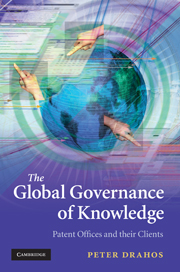Book contents
- Frontmatter
- Contents
- List of diagrams and tables
- List of abbreviations
- Preface
- 1 Patent offices and the global governance of knowledge
- 2 Labyrinths and catacombs: Patent office procedure
- 3 The rise of patent offices
- 4 The Sun and its planets: The European Patent Office and national offices
- 5 The USPTO and JPO
- 6 The age of Trilaterals and the spirit of cooperation
- 7 The jewel in the crown: India's Patent Office
- 8 The dragon and the tiger: China and South Korea
- 9 Joining the patent office conga line: Brazil
- 10 Islands and regions in the patent stream
- 11 Reclaiming the patent social contract
- 12 Patent administration sovereignty: Nodal solutions for small countries, developing countries
- Index
- References
9 - Joining the patent office conga line: Brazil
Published online by Cambridge University Press: 03 May 2010
- Frontmatter
- Contents
- List of diagrams and tables
- List of abbreviations
- Preface
- 1 Patent offices and the global governance of knowledge
- 2 Labyrinths and catacombs: Patent office procedure
- 3 The rise of patent offices
- 4 The Sun and its planets: The European Patent Office and national offices
- 5 The USPTO and JPO
- 6 The age of Trilaterals and the spirit of cooperation
- 7 The jewel in the crown: India's Patent Office
- 8 The dragon and the tiger: China and South Korea
- 9 Joining the patent office conga line: Brazil
- 10 Islands and regions in the patent stream
- 11 Reclaiming the patent social contract
- 12 Patent administration sovereignty: Nodal solutions for small countries, developing countries
- Index
- References
Summary
Brazil: the nineteenth century
The Portuguese Crown's colonization of Brazil did not produce the kind of colonial administration of patents that the British Crown institutionalized in India. Portugal was itself a comparative latecomer to patent law. Its first patent law appears to be a royal decree of 1837 that set up a registration system for patents in which a description of the invention had to be deposited with the relevant provincial administration of the inventor along with the payment of a fee. In return the inventor received a patent, but without any guarantees as to its validity.
Brazil achieved independence from Portugal in 1822. Prior to independence Brazil had become the centre of the Portuguese Empire as Prince Regent Dom João, fleeing Napoleon, set up court in Brazil in 1808. In 1809 he created the alvará, a law aimed at stimulating industrial activity in an economy dominated by agriculture. Before this law there is some evidence that a European-like privilege system operated in Brazil. This alvará was inspired by the English Statute of Monopolies and followed its basic lines of protection for inventions. Brazil's first constitution of 1824 recognized the right of inventors to a temporary exclusive privilege or remuneration for the use of their invention. This was followed by a law of 1830 that recognized the rights of inventors. Privileges were granted for 5 to 20 years according to the nature of the invention.
- Type
- Chapter
- Information
- The Global Governance of KnowledgePatent Offices and their Clients, pp. 242 - 256Publisher: Cambridge University PressPrint publication year: 2010

